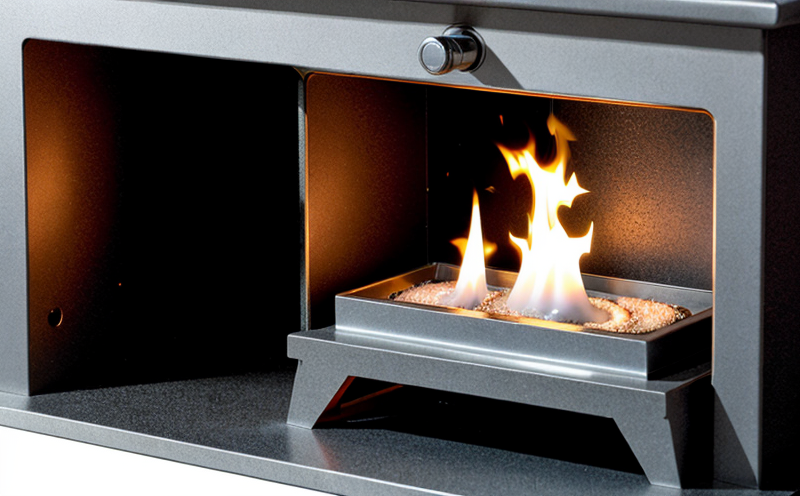Flame Spread Testing of Wooden Flooring Materials
The importance of flame spread testing in wooden flooring materials cannot be overstated. This testing is a critical component of ensuring the safety and compliance with fire regulations for buildings and structures that utilize these materials.
The primary objective of flame spread testing is to determine the relative burning characteristics of different wooden flooring products under controlled conditions. By quantifying how quickly flames can spread over the surface of these materials, we provide valuable data that helps in selecting safer building materials.
Flame spread testing typically involves exposing a standardized specimen to an open flame or heat source and measuring the distance it takes for the fire to spread across the sample. The results are expressed as a Flame Spread Index (FSI), which is compared against industry standards such as ASTM E84-21, ISO 6702:2009, and EN 13501-1.
For wooden flooring materials, the test setup usually includes a specially designed apparatus that allows for consistent application of heat. The apparatus is calibrated to ensure accurate measurements across all tests. Specimens are prepared according to specific guidelines to maintain consistency in testing results. This preparation often involves cutting uniform samples from the material, ensuring they meet the required dimensions and thickness.
The test itself can be conducted in a variety of configurations depending on the desired outcome. For instance, you might want to measure not just the spread but also the time it takes for flames to extinguish after being applied. These additional metrics provide deeper insights into the material's performance under fire conditions.
Understanding how different types of wood and finishes affect flame spread behavior is crucial for material selection in fire safety design. Species like pine, oak, or bamboo can vary significantly in their combustibility properties. Similarly, treatments such as kiln drying, pressure impregnation, or application of fire retardants will influence the outcome of the test.
- Environmental and Sustainability Contributions: Flame spread testing supports sustainable construction practices by ensuring that only safe materials are used in buildings. This not only enhances public safety but also contributes to reducing potential environmental damage from fires.
- Use Cases and Application Examples: In practice, this service is often requested when a manufacturer needs to comply with fire codes for new product introductions or modifications. Additionally, it can be used during the research phase of developing safer and more sustainable building materials.
Why It Matters
The significance of flame spread testing extends beyond mere compliance with regulations; it plays a pivotal role in protecting lives, property, and the environment. In fire safety design, every precaution is essential to minimize risks associated with the spread of flames.
When designing buildings or selecting materials for renovation projects, understanding how different wooden flooring products behave under fire conditions can make all the difference. By knowing which materials are more likely to contribute to rapid flame spread, architects and engineers can design safer spaces that enhance occupant safety.
The results of flame spread testing also help manufacturers improve their products by identifying areas where they could enhance the fire resistance properties of wooden flooring. This iterative process ensures continuous improvement in material performance over time.
Moreover, compliance with relevant standards such as ASTM E84-21 is crucial for ensuring that the materials used meet safety requirements set forth by governing bodies. Meeting these standards can prevent legal issues and enhance the reputation of both manufacturers and end-users.
In summary, flame spread testing serves multiple purposes: it ensures compliance with fire codes, improves product performance, enhances occupant safety, supports sustainable practices, and contributes to overall public welfare.
Environmental and Sustainability Contributions
- Sustainable Resource Management: By selecting materials that perform well in flame spread testing, we help promote responsible use of natural resources. This reduces the likelihood of accidents that could lead to extensive damage or loss.
- Eco-Friendly Building Practices: The results from this testing contribute towards greener building practices by favoring products that are less prone to rapid flame spread. Such materials typically have lower environmental impacts throughout their lifecycle.
The use of flame spread testing in wooden flooring selection supports broader sustainability goals, including reducing the carbon footprint and promoting circular economy principles within construction sectors.
Use Cases and Application Examples
- New Product Introductions: When launching a new wooden flooring product or making modifications to an existing one, flame spread testing is essential for ensuring that the materials meet required safety standards.
- R&D Phase: During the research and development stages of innovative wood products, this type of testing helps identify which materials offer superior fire resistance properties. This information can guide further product development efforts towards more robust solutions.
In addition to these primary use cases, flame spread testing may also be employed during certification processes or when addressing specific client requests regarding material performance under fire conditions.





